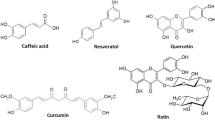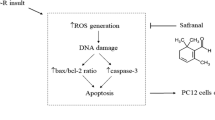Summary
In this study, we show that safranine at the concentrations usually employed as a probe of mitochondrial membrane potential significantly protects against the oxidative damage of mitochondria induced by Fe(II)citrate. The effect of safranine was illustrated by experiments showing that this dye strongly inhibits both production of thiobarbituric acid-reactive substances and membrane potential decrease when energized mitochondria were exposed to Fe(II)citrate in the presence of Ca2+ ions. Similar results were obtained with the lipophylic compound trifluoperazine. It is proposed that, like trifluoperazine, safranine decreases the rate of lipid peroxidation due to its insertion in the membrane altering the physical state of the lipid phase.
Similar content being viewed by others
References
Dell’Antone P., Colonna R., Azzone G.F. (1972): The membrane structure studied with cationic dyes. I. The binding of cationic dyes to submitochondrial particles and the question of the polarity of the ion-translocation. Eur. J. Biochem., 24, 553–565.
Colonna R., Massari S., Azzone G.F. (1973): The problem of cation-binding sites in the energized membrane of intact mitochondrial. Eur. J. Biochem., 34, 577–585.
Åkerman K.E.O., Wikström M.K.F. (1976): Safranine as a probe of the mitochondrial membrane potential, FEBS Lett., 68, 191–197.
Zanotti A., Azzone G.F. (1980): Safranine as membrane potential probe in rat liver mitochondria. Arch. Biochem. Biophys., 201, 255–265.
Valle V.G.R., Pereira-da-Silva L., Vercesi A.E. (1986): Undesirable feature of safranine use as a probe for mitochondrial membrane potential. Biochem. Biophys. Res. Commn., 135, 189–195.
Schneider W. C., Hogerboom G. H. (1950): Intracellular distribution of enzymes. V. Further studies on the distribution of cytochrome a in rat liver homogenates. J. Biol. Chem. 183, 213–228.
Kamo N., Muratsugo M., Ruji H., Kobatake J. (1979): Membrane potential of mitochondria measured with an electrode sensitive to tetraphenyl phosphonium and relationship between proton electrochemical potential phosphorylation potential in steady state. J. Membr. Biol., 48, 105–121.
Muratsugu M., Kamo N., Kurihara K., Kobatake J. (1977): Selective electrode for dibenzyl ammonium cation as indicator of the membrane potential in biological systems. Biochim. Biophys. Acta, 464, 613–619.
Jensen B.D., Gunter K.K., Gunter T.E. (1986): The efficiencies of the component steps of oxidative phosphorylation. II. Experimental determination of the efficiencies in mitochondria and examination of the equivalence of membrane potential and pH gradient in phosphorylation. Arch. Biochem. Biophys. 248, 305–323.
Vercesi A.E., Bernardes C.F., Hoffmann M.E., Gadelha F.R., Docampo R. (1991): Digitonin permeabilization does not affect mitochondrial function and allows the determination of the mitochondrial membrane potential ofTrypanosoma cruzi in situ. J. Biol. Chem., 266, 14431–14434.
Buege J.A., Aust S.D. (1978): Microsomal lipid peroxidation. Methods Enzymol., 52, 302–310.
Castilho R.F., Meinicke A.R., Almeida A.M., Hermes-Lima M., Vercesi A.E. (1994): Oxidative damage of mitochondria induced by Fe(II)citrate is potentiated by Ca2+ and includes lipid peroxidation and alterations in membrane proteins. Arch. Biochem. Biophys., 308, 158–163.
Castilho R.F., Kowaltowski A.J., Meinicke A.R., Vercesi A.E. (1995): Oxidative damage of mitochondria induced by Fe(II)citrate ort-butyl hydroperoxide in the presence of Ca2+: effect of coenzyme Q redox state. Free Rad. Biol. Med., 18, 55–59.
Slater T.F. (1968): The inhibitory effects ‘in vitro’ of phenothiazines and other drugs on lipid peroxidation systems in rat liver microsomes and their relatioship to liver necrosis produced by carbon tetrachloride. Biochem. J., 106, 155–160.
Janero D.R., Burghardt B. (1989): Prevention of oxidative injury to cardiac phospholipids by membrane-active ‘stabilizing agents’. Res. Commun. Chem. Pathol. Pharmacol., 63, 163.
Breugnot C., Mazière C., Salmon S., et al. (1990): Phenothiazines inhibit copper and endothelial cell-induced peroxidation of low density lipoprotein. Biochem. Pharmacol., 40, 1975–1980.
Pereira R.S., Bertocchi A.P.F., Vercesi A.E. (1992): Protective effect of trifluoperazine on the mitochondrial damage induced by Ca2+ plus prooxidants. Biochem. Pharmacol., 44, 1795–1801.
Author information
Authors and Affiliations
Rights and permissions
About this article
Cite this article
Castilho, R.F., Pereira, R.S. & Vercesi, A.E. Protective effect of safranine on the mitochondrial damage induced by Fe(II)citrate: comparative study with trifluoperazine. European Journal of Drug Metabolism and Pharmacokinetics 21, 17–21 (1996). https://doi.org/10.1007/BF03190273
Received:
Issue Date:
DOI: https://doi.org/10.1007/BF03190273




